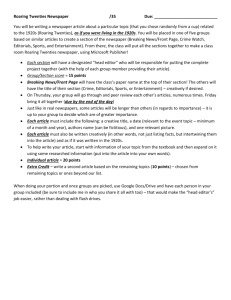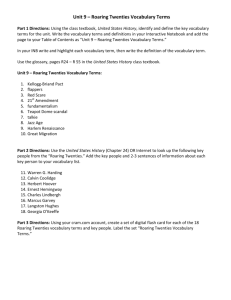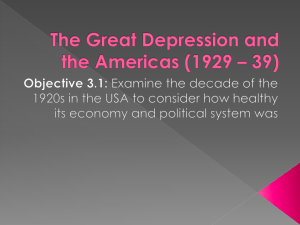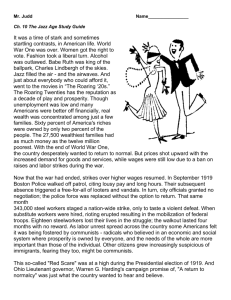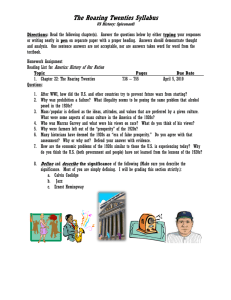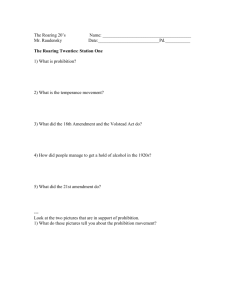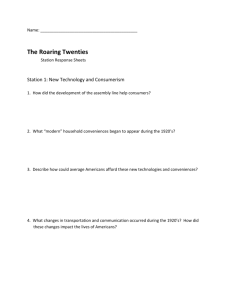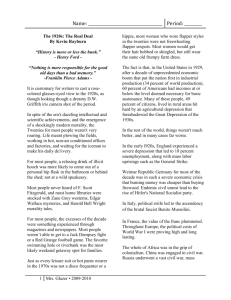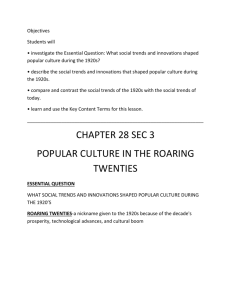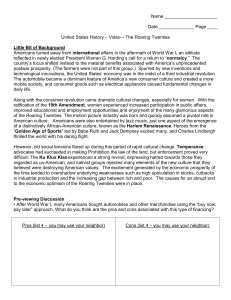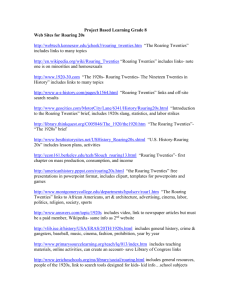Unit6_Lesson_Plans
advertisement
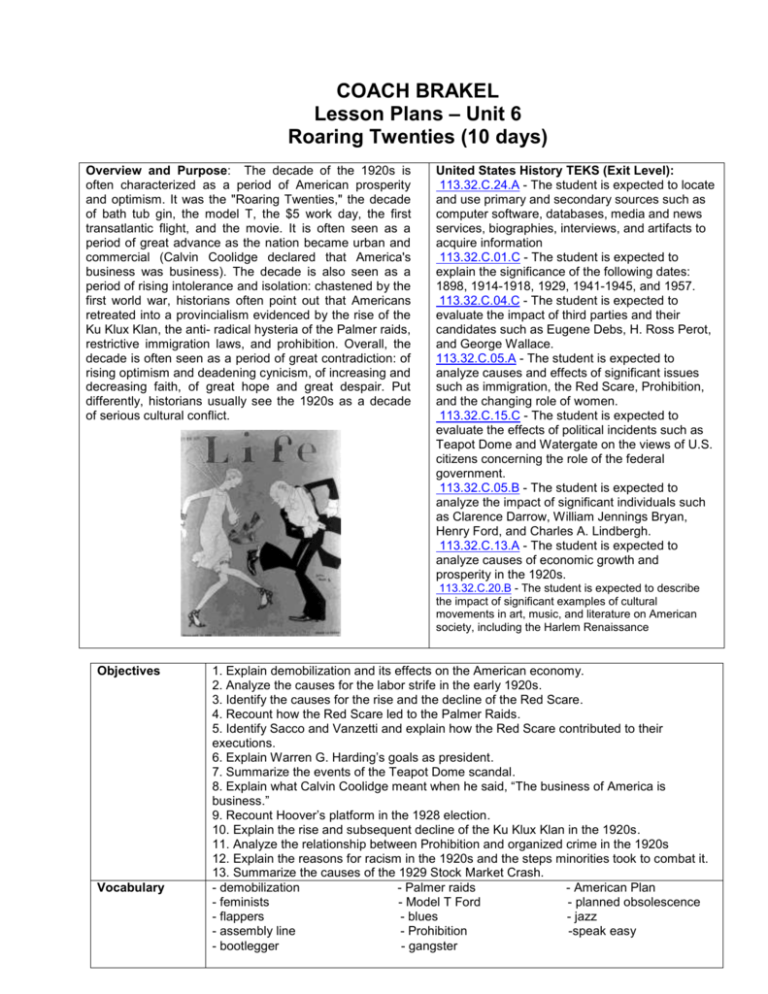
COACH BRAKEL Lesson Plans – Unit 6 Roaring Twenties (10 days) Overview and Purpose: The decade of the 1920s is often characterized as a period of American prosperity and optimism. It was the "Roaring Twenties," the decade of bath tub gin, the model T, the $5 work day, the first transatlantic flight, and the movie. It is often seen as a period of great advance as the nation became urban and commercial (Calvin Coolidge declared that America's business was business). The decade is also seen as a period of rising intolerance and isolation: chastened by the first world war, historians often point out that Americans retreated into a provincialism evidenced by the rise of the Ku Klux Klan, the anti- radical hysteria of the Palmer raids, restrictive immigration laws, and prohibition. Overall, the decade is often seen as a period of great contradiction: of rising optimism and deadening cynicism, of increasing and decreasing faith, of great hope and great despair. Put differently, historians usually see the 1920s as a decade of serious cultural conflict. United States History TEKS (Exit Level): 113.32.C.24.A - The student is expected to locate and use primary and secondary sources such as computer software, databases, media and news services, biographies, interviews, and artifacts to acquire information 113.32.C.01.C - The student is expected to explain the significance of the following dates: 1898, 1914-1918, 1929, 1941-1945, and 1957. 113.32.C.04.C - The student is expected to evaluate the impact of third parties and their candidates such as Eugene Debs, H. Ross Perot, and George Wallace. 113.32.C.05.A - The student is expected to analyze causes and effects of significant issues such as immigration, the Red Scare, Prohibition, and the changing role of women. 113.32.C.15.C - The student is expected to evaluate the effects of political incidents such as Teapot Dome and Watergate on the views of U.S. citizens concerning the role of the federal government. 113.32.C.05.B - The student is expected to analyze the impact of significant individuals such as Clarence Darrow, William Jennings Bryan, Henry Ford, and Charles A. Lindbergh. 113.32.C.13.A - The student is expected to analyze causes of economic growth and prosperity in the 1920s. 113.32.C.20.B - The student is expected to describe the impact of significant examples of cultural movements in art, music, and literature on American society, including the Harlem Renaissance Objectives Vocabulary 1. Explain demobilization and its effects on the American economy. 2. Analyze the causes for the labor strife in the early 1920s. 3. Identify the causes for the rise and the decline of the Red Scare. 4. Recount how the Red Scare led to the Palmer Raids. 5. Identify Sacco and Vanzetti and explain how the Red Scare contributed to their executions. 6. Explain Warren G. Harding’s goals as president. 7. Summarize the events of the Teapot Dome scandal. 8. Explain what Calvin Coolidge meant when he said, “The business of America is business.” 9. Recount Hoover’s platform in the 1928 election. 10. Explain the rise and subsequent decline of the Ku Klux Klan in the 1920s. 11. Analyze the relationship between Prohibition and organized crime in the 1920s 12. Explain the reasons for racism in the 1920s and the steps minorities took to combat it. 13. Summarize the causes of the 1929 Stock Market Crash. - demobilization - Palmer raids - American Plan - feminists - Model T Ford - planned obsolescence - flappers - blues - jazz - assembly line - Prohibition -speak easy - bootlegger - gangster Teacher Presentation Student Notebook (Most of this work will be completed in class) Assessment – Unit 6 Day 1 Introduce Knowledge Rating Chart Vocabulary Definitions for the Roaring Twenties. Introduce the mini-project, going through the project with students and giving specific due dates for each Activity. Day 2 Reading Notes – use “Postwar Troubles GO” Day 3 Begin PowerPoint Presentation: “The Roaring Twenties.” Have students take notes on the PowerPoint presentation using the illustrated outline ”The Red Scare and More Labor Unrest.” Day 4 Finish PowerPoint Presentation: “The Roaring Twenties.” Student Work Day Day 5 Student Work Day Activities 1 and 2 due. Day 6 Student Work Day Day 7 Student Work Day Day 8 Student Work Day – Student Notebook Activities 3-5 due today Test Review Day 9 Administer the test over the Roaring Twenties. Student Notebook Activities 1. Sensory Figure – The Flapper 2. Advertisement – Boom Times 3. Circle ThinkingMap – Prohibition 4. Sensory Figure – Charles Lindberg 5. Double Bubble ThinkingMap – The Scopes Trial Test: Unit 7 – The Roaring Twenties Sequencing: Unit 7 – The Roaring Twenties Unit Day Day 1 Day 2 Day 3 Day 4 Day 5 Activities Timeline – 8 days Laptops Needed Warm Up – Define demobilization. 1. Have students share their answers with their table partners. 2. Illustrated Dictionary Definitions – The Roaring Twenties. Turn this in before you leave the classroom. Laptops Not Needed 1. Warm up – Read page 390-396 of the textbook. Define Red Scare. 2. Complete PowerPoint Presentation: “The Roaring Twenties.” 3. Complete the PowerPoint notes the illustrated outline ”The Red Scare and More Labor Unrest.” These are due at the end of the period. Laptops Needed 1. Warm up – Define tariff and explain how the Tariff Act of 1924 contributed to economic prosperity in the United States in the 1920s. 2. Student directed workday. Work on Student Notebook activities. Laptops Needed 1. Warm Up: Define “flapper” 2. Student directed workday. Work on Student Notebook activities and turn them in at the end of the period. 3. Complete the test review over Chapters 13 and 14 for homework Test: The Roaring Twenties, Chapters 13 and 14.
